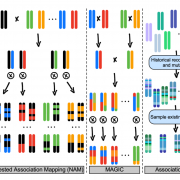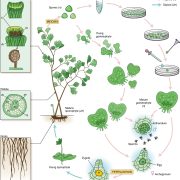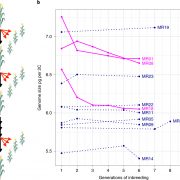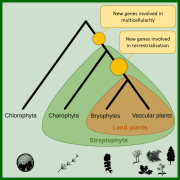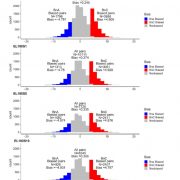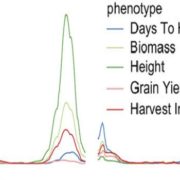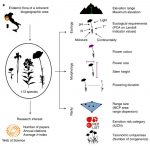Large-scale whole-genome resequencing unravels the domestication history of Cannabis sativa (Science Advances)
 Throughout history, many cultures have exploited the properties of Cannabis sativa, either as a source of fiber extracts (hemp) or as a medicinal and recreational drug (drug type). It is thought that cannabis was originally cultivated in Asia from where it spread to other regions around the globe, and it was during this process that artificial selection and outcrossing with other cultivars or landraces occurred. Cannabis produce two main types of secondary metabolites: cannabidiolic acid (CBDA) and Δ9-tetrahydrocannabinolic acid (THCA). These compounds are of medical importance because they bind to endocannabinoid receptors in an animal’s nervous system and could treat some neurological disorders. Cannabis hemp, drug types, and hybrid cultivars differ in their relative yield of these compounds and have been classified according to their chemotype. Despite the long history of cannabis use and the need to produce varieties with specific cannabinoid profiles, the genomic history of domestication and the mechanisms mediating the evolution of cannabinoid synthase genes has been understudied. Here, the authors investigated C. sativa domestication history by analyzing whole-genome profiles of 110 accessions distributed around the world. They showed that C. sativa was first domesticated in early Neolithic times in East Asia. Phylogenetic analysis showed a strong clustering of Cannabis accessions into four well-separated genetic groups [A) Basal, B) Hemp-type, C) Drug-type feral and D) Drug-type] and suggest that all current hemp and drug cultivars diverged from an ancestral gene pool represented by feral plants and landraces in China. Additionally, the authors identified a set of specific candidate genes that appeared to have been under selection differentiating hemp and drug types. Such genes affected traits that where expected to have been under selection, such as branching pattern and cellulose/lignin biosynthesis, leading to unbranched, cellulose-rich/lignin-poor bast fibers in hemp types versus well-branched with lignin-rich woody cores, maximizing flower and resin production in drug types. Interestingly, the authors also found that genes involved in the synthesis of the two major biochemically competing cannabinoids THCAS or CBDAS were lost during domestication for increased fiber production or psychoactive properties respectively. In conclusion, this study provides insights into the domestication history of C. sativa and identifies putative genes that have been under selection, supporting an evolutionary scenario that accounts for the variability in cannabinoid composition. Furthermore, the study offers an unprecedented base of genomic resources for breeders for both medical and agricultural applications. (Summary by Daniela Ramos @DanielaR_cruz) Sci. Adv. 10.1126/sciadv.abg2286
Throughout history, many cultures have exploited the properties of Cannabis sativa, either as a source of fiber extracts (hemp) or as a medicinal and recreational drug (drug type). It is thought that cannabis was originally cultivated in Asia from where it spread to other regions around the globe, and it was during this process that artificial selection and outcrossing with other cultivars or landraces occurred. Cannabis produce two main types of secondary metabolites: cannabidiolic acid (CBDA) and Δ9-tetrahydrocannabinolic acid (THCA). These compounds are of medical importance because they bind to endocannabinoid receptors in an animal’s nervous system and could treat some neurological disorders. Cannabis hemp, drug types, and hybrid cultivars differ in their relative yield of these compounds and have been classified according to their chemotype. Despite the long history of cannabis use and the need to produce varieties with specific cannabinoid profiles, the genomic history of domestication and the mechanisms mediating the evolution of cannabinoid synthase genes has been understudied. Here, the authors investigated C. sativa domestication history by analyzing whole-genome profiles of 110 accessions distributed around the world. They showed that C. sativa was first domesticated in early Neolithic times in East Asia. Phylogenetic analysis showed a strong clustering of Cannabis accessions into four well-separated genetic groups [A) Basal, B) Hemp-type, C) Drug-type feral and D) Drug-type] and suggest that all current hemp and drug cultivars diverged from an ancestral gene pool represented by feral plants and landraces in China. Additionally, the authors identified a set of specific candidate genes that appeared to have been under selection differentiating hemp and drug types. Such genes affected traits that where expected to have been under selection, such as branching pattern and cellulose/lignin biosynthesis, leading to unbranched, cellulose-rich/lignin-poor bast fibers in hemp types versus well-branched with lignin-rich woody cores, maximizing flower and resin production in drug types. Interestingly, the authors also found that genes involved in the synthesis of the two major biochemically competing cannabinoids THCAS or CBDAS were lost during domestication for increased fiber production or psychoactive properties respectively. In conclusion, this study provides insights into the domestication history of C. sativa and identifies putative genes that have been under selection, supporting an evolutionary scenario that accounts for the variability in cannabinoid composition. Furthermore, the study offers an unprecedented base of genomic resources for breeders for both medical and agricultural applications. (Summary by Daniela Ramos @DanielaR_cruz) Sci. Adv. 10.1126/sciadv.abg2286


